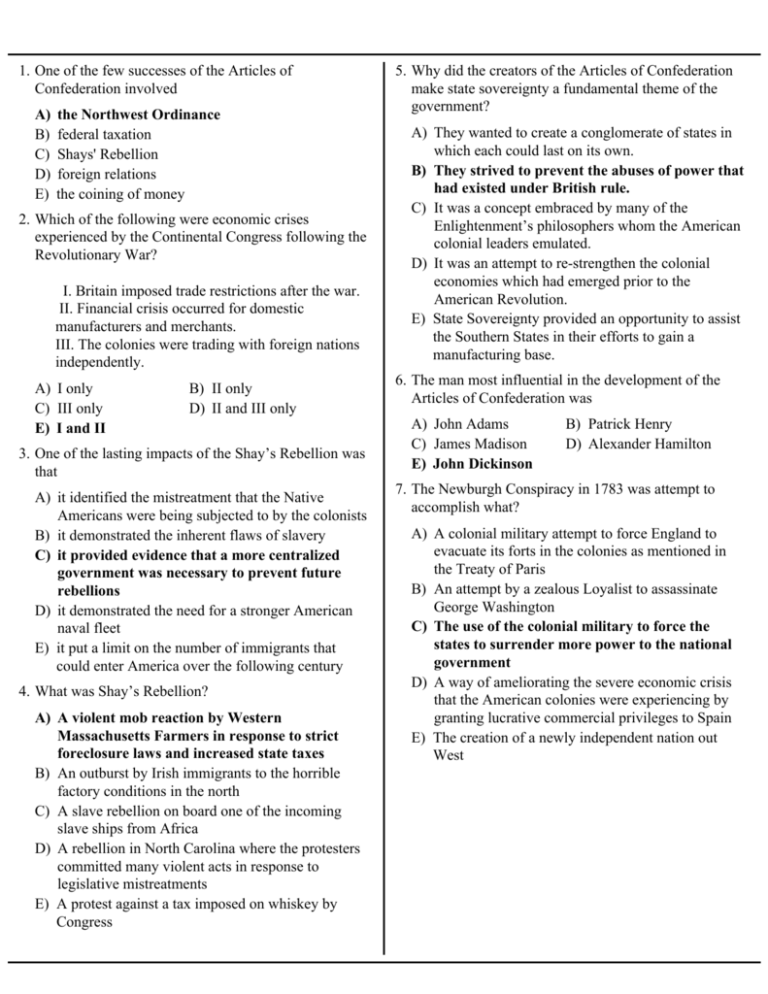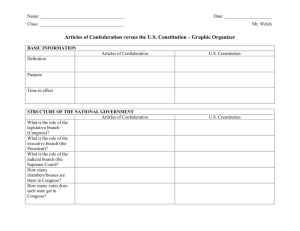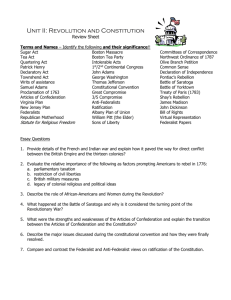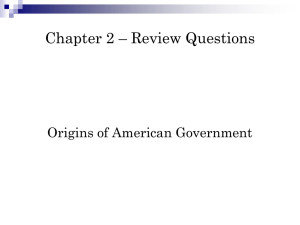
1. One of the few successes of the Articles of
Confederation involved
A)
B)
C)
D)
E)
the Northwest Ordinance
federal taxation
Shays' Rebellion
foreign relations
the coining of money
2. Which of the following were economic crises
experienced by the Continental Congress following the
Revolutionary War?
I. Britain imposed trade restrictions after the war.
II. Financial crisis occurred for domestic
manufacturers and merchants.
III. The colonies were trading with foreign nations
independently.
A) I only
C) III only
E) I and II
B) II only
D) II and III only
3. One of the lasting impacts of the Shay’s Rebellion was
that
A) it identified the mistreatment that the Native
Americans were being subjected to by the colonists
B) it demonstrated the inherent flaws of slavery
C) it provided evidence that a more centralized
government was necessary to prevent future
rebellions
D) it demonstrated the need for a stronger American
naval fleet
E) it put a limit on the number of immigrants that
could enter America over the following century
4. What was Shay’s Rebellion?
A) A violent mob reaction by Western
Massachusetts Farmers in response to strict
foreclosure laws and increased state taxes
B) An outburst by Irish immigrants to the horrible
factory conditions in the north
C) A slave rebellion on board one of the incoming
slave ships from Africa
D) A rebellion in North Carolina where the protesters
committed many violent acts in response to
legislative mistreatments
E) A protest against a tax imposed on whiskey by
Congress
5. Why did the creators of the Articles of Confederation
make state sovereignty a fundamental theme of the
government?
A) They wanted to create a conglomerate of states in
which each could last on its own.
B) They strived to prevent the abuses of power that
had existed under British rule.
C) It was a concept embraced by many of the
Enlightenment’s philosophers whom the American
colonial leaders emulated.
D) It was an attempt to re-strengthen the colonial
economies which had emerged prior to the
American Revolution.
E) State Sovereignty provided an opportunity to assist
the Southern States in their efforts to gain a
manufacturing base.
6. The man most influential in the development of the
Articles of Confederation was
A) John Adams
C) James Madison
E) John Dickinson
B) Patrick Henry
D) Alexander Hamilton
7. The Newburgh Conspiracy in 1783 was attempt to
accomplish what?
A) A colonial military attempt to force England to
evacuate its forts in the colonies as mentioned in
the Treaty of Paris
B) An attempt by a zealous Loyalist to assassinate
George Washington
C) The use of the colonial military to force the
states to surrender more power to the national
government
D) A way of ameliorating the severe economic crisis
that the American colonies were experiencing by
granting lucrative commercial privileges to Spain
E) The creation of a newly independent nation out
West
8. Which best explains the dissatisfaction of the merchant
class with the Articles of Confederation?
A) Congress’ power to tax was unlimited.
B) Individual states lacked the power to regulate
commerce.
C) The President’s treaty-making power was
unchecked.
D) There was no provision for a uniform currency.
E) Congress did not have the right to borrow money
from other nations.
9. What were the “Continentals”?
A) new regions that had been settled west of the
Appalachians
B) fervent supporters of the Articles of Confederation
C) native-Americans who settled within the colonies
and accepted the Articles of Confederation
D) large amounts of paper money which Congress
had to print since it could not levy taxes
E) representatives who attended the meetings of the
Continental Congress
10. The Articles of Confederation was given permission to
do all of the following EXCEPT
A)
B)
C)
D)
E)
control foreign policy
settle disputes between states
control interstate commerce
borrow money from other nations
admit new states into the Union
11. One similarity between the policies under the
Continental Congress and the Articles of Confederation
was
A) the right to make war and to sign treaties
B) a unicameral congress in which each state
would have one vote
C) Congressional sessions would always take place in
either Washington D.C. or New York City
D) neither Congress had the right to act as an
intermediary and settle disputes between states
E) both governments were allowed to print currency
12. The development of the Articles of Confederation in
1777 arose from the
A) need for a stronger union and a government
powerful enough to defeat Great Britain
B) suggestion by Alexander Hamilton to create a
central government to dictate military strategy
C) belief that a new nation must have a constitutional
order appropriate to its republican character
D) agreement made by the Second Continental
Congress to create a permanent institution to
dictate colonial affairs.
E) need for foreign recognition and aid
13. The Great Compromise between the Virginia and New
Jersey plans addressed
A) North and South state disagreement over how
slaves should be counted in the population
B) representation in the legislature determined by
population or per state
C) the creation of a national bank and the location of
the U.S. capital
D) large and small state divisions over assumption of
states' debt by the federal government
E) the structure of federalism favoring the state or
national governments
14. The power to tax, the power to regulate interstate
commerce, and three separate branches of government
with checks and balances are all examples of
A) characteristics that state governments shared with
the national government
B) ideas borrowed by Americans from Enlightenment
philosophers
C) laws established by the Bill of Rights and other
Amendments
D) goals of the Founding Fathers in fighting the
Revolutionary War
E) changes in the structure of the federal
government made by the Constitution from the
Articles of Confederation
15. The electoral college was created to
A)
B)
C)
D)
E)
ensure fair elections
protect the president from popular sentiment
limit state autonomy
weaken the legislative branch
weaken the executive branch
16. The Federalist Papers were written to
A)
B)
C)
D)
E)
argue for national independence
promote the Articles of Confederation
demand a Bill of Rights
support ratification of the Constitution
set the platform for the Federalist Party
17. The Great Compromise at the Constitutional
Convention dealt with the issue of
A)
B)
C)
D)
E)
citizens' representation
slavery
trade
the presidency
ratification
18. Patrick Henry and John Hancock were not selected as
delgates to the Constitutional Convention, perhaps
because
A) they were generally opposed to centralized
government
B) at the time, their heroism had not yet been
recognized
C) they were part of a lower social class than most
delegates
D) they did not sign the Declaration of Independence
E) many believed they were still loyal to the British
crown
19. The direct result of the Annapolis Convention was the
A)
B)
C)
D)
E)
Declaration of Independnce
U.S. Constitution
Articles of Confederation
Constitutional Convention
Second Continental Congress
20. According to the original, un-amended Constitution, the
American people must directly elect which of the
following?
A)
B)
C)
D)
E)
The President
Senators
Representatives
Secretary of State
The Electoral College
21. Which of the following is not a right reserved to the
federal government, as established by Article I of the
Constitution?
A) The granting of copyrights and patents
B) The regulation of intrastate commerce
C) The power to borrow money in the name of the
United States
D) The authority to establish a national immigration
policy
E) The ability to establish courts inferior to the
Supreme Court
22. On a demographic level, the adoption of the
Constitution did not significantly change from the
Articles of Confederation because
A) the Constitution appointed a Electoral College to
elect the President
B) women, slaves, Native Americans, and free
blacks were completely disenfranchised
C) only one representative from each colony was
given the right to vote
D) only white men of the wealthiest class had any
political power in the newly-established
government
E) voting rights were based on inheritance
23. The ratification of the Bill of Rights in 1791 illustrated
a commitment to
A) limiting the power of state governments
B) expanding the power of Congress
C) satisfying the political desires of both Federalists
and Anti-Federalists
D) protecting individual liberties
E) giving the states and the national government
equal power
24. Initially-reluctant states like Virginia and
Massachusetts finally agreed to ratify the Constitution
with the promise of what?
A) The creation of Supreme Court
B) Establishment of the nation's capital city in
Washington D.C.
C) Adoption of a Bill of Rights
D) George Washington would be appointed President
E) Alexander Hamilton had to resign from the
political arena
25. Who of the following composed The Federalist Papers,
a series of eighty-five newspaper essays arguing for
the support of the Constitution?
A) Luther Martin, John Hancock, and Samuel Adams
B) Alexander Hamilton, George Washington, and
James Madison
C) George Mason, John Jay, and John Hancock
D) James Madison, Alexander Hamilton, and John
Jay
E) John Marshall, James Madison, and George
Washington
26. What was one advantage that the Anti-Federalists had
above the Federalists?
A) They offered a clear prescription for the nation’s
ills.
B) They were a well-organized organization, with
definite political leaders and supporters.
C) The Anti-Federalists were better financed than the
Federalist party.
D) They had the support of the two most prominent
national politicians, Benjamin franklin and George
Washington.
E) The Anti-Federalists had the support of most
state politicians and the American people.
27. All of the following were strong advocates of the
Federalist Party EXCEPT
A)
B)
C)
D)
E)
John Adams
Alexander Hamilton
George Mason
John Jay
James Madison
28. The agreement about the issue of slavery made by the
Constitutional delegates was known as the
A)
B)
C)
D)
E)
New Jersey Plan
Virginia Plan
Three-Fifths Compromise
The Great Compromise
Bill of Rights
29. At the Constitutional Convention in the summer of
1787, James Madison and Edmund Randolph devised a
plan of national government known as the “Virginia
Plan” which called for what?
A) The establishment of an executive branch and a
bicameral congress each with representatives
elected by population
B) The creation of a three-branch form of government
with an executive, legislative, and judicial branch
each with headquarters in Richmond, Virginia
C) A form of government with a unicameral
legislature with equal representation for the states
D) A bicameral system with one house based on
population and the other with an equal number of
representatives
E) A highly-centralized government where the
President would have complete control over
foreign policy and the power to veto Congress’
legislation
30. Federalists' principal objections to a Bill of Rights were
addressed in the
A)
B)
C)
D)
E)
First Amendment
Second Amendment
Fourth Amendment
Fifth Amendment
Ninth Amendment
31. The tenth amendment of the Bill of Rights was
significant in particular, because it
A) defined the rule of the construction of the
Constitution
B) guaranteed trial by jury
C) provided for laws concerning prosecution,
including the requirement of a grand-jury
indictment and the protection from testifying
against oneself
D) guaranteed that any powers not specifically
delegated to the federal government or denied
to the states in the Constitution rest with the
states or the people
E) gave the right to bear arms
32. The Bill of Rights included all of the following
EXCEPT
A) the first twelve amendments made to the
Constitution
B) a means of limiting the power of the federal
government to those specified in the Constitution
C) a way of securing the rights of individual citizens
D) a promise by Federalists to meet some of the
desires of the Anti-Federalists as long as they
ratified the Constitution
E) ideas mainly developed by George Mason and
James Madison
33. The main reason why the Federalists originally rejected
the idea of creating a Bill of Rights was that
A) they feared that the Anti-Federalists could use
such a document as a means of gaining power
B) they didn’t see the necessity of it since the
Constitution already enumerated all of the
rights of the national government
C) it would require more time before a national
government could be implemented and thus
continue to leave the nation vulnerable
D) they didn’t want to give in to the demands of the
Anti-Federalists
E) they felt that the Bill of Rights went against their
philosophy of a centralized national government
34. The Bill of Rights that was adopted by the
Constitutional Delegates was filled with the philosophy
of which philosopher who wrote extensively about the
natural rights of mankind against injustice?
A)
B)
C)
D)
E)
John Locke
Thomas Hobbes
Jean-Jacques Rousseau
Aristotle
Plato
35. The roots of the Bill of Rights lie in which document
from Anglo-American history?
A)
B)
C)
D)
E)
The Mayflower Compact
Magna Carta
Declaration of Independence
Treaty of Paris
Declaration of the Rights of Man
Answer Key
Constitution Review Mazzini
1.
A
2.
E
3.
C
4.
A
5.
B
6.
E
7.
C
8.
D
9.
D
10.
C
11.
B
12.
A
13.
B
14.
E
15.
B
16.
D
17.
A
18.
A
19.
D
20.
C
21.
B
22.
B
23.
D
24.
C
25.
D
26.
E
27.
C
28.
C
29.
A
30.
E
31.
D
32.
A
33.
B
34.
A
35.
B







